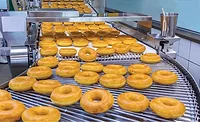TECH FLASH
Manufacturers meet the demand for new product varieties without sacrificing quality
To do this successfully, they must maximize line flexibility, producing a wider range of products in smaller volumes
According to market research firm Mintel, 47 percent of Americans snack at least once a day, and 35 percent eat snacks in place of regular meals.
To shed some light on the trends and innovations driving the baking and snack industry, PMMI spoke with Madinah Allen, senior director, corporate engineering and technology at Snyder’s-Lance, Inc. Allen participates in The Engineering Solutions Group of the Alliance for Innovation & Operational Excellence (AIOE) founded in 2011 by PMMI, The Association for Packaging and Processing Technology.
Q? What changes in consumer buying habits are affecting the baking and snack sectors?
Allen: Consumers have made it clear that they want high-quality products that can be eaten while on-the-go, working or relaxing. Some new snack foods come in packages that can easily be resealed, allowing for nibbling throughout a busy day. Consumers have shown they will pay more for convenience.
In addition, a growing number of health-conscious consumers are seeking products that meet their special dietary needs, and the demand for gluten-free products continues to rise. Once dismissed as a fad, the gluten-free “trend” is here to stay. Many consumers—with or without a gluten sensitivity—choose to remove the protein from their diets. According to Mintel, sales of gluten-free products are expected to top $15 billion in 2016—almost a $5 billion increase from last year's expected sales. As manufacturers continue to focus on this growing market segment, consumers will see greater product variety on store shelves.
Q? How is this demand for greater product variety and convenience-enhancing formats affecting manufacturers?
Allen: Manufacturers must meet the demand for new product varieties without sacrificing quality, even if this means producing a wider range of products in smaller volumes. To do this successfully, they must maximize line flexibility.
But before undertaking a major retrofit or building a new line, engineers must examine existing lines to determine where flexibility and efficiency can be improved, and decide which technologies best complement current equipment. In the end, manufacturers need cost-effective systems that can produce the highest-quality products.
Much of the new food production equipment we’re seeing is modular in design, which means faster changeover times and—critically—better sanitation. Gluten-free products, for example, must be produced without contamination from ingredients containing gluten. By using modular equipment, manufacturers can meet the most stringent food safety requirements while minimizing changeover time.
Q? How is the use of automation and robotics continuing to spread in the baking and snack industry?
Allen: The use of robots and automation is increasing among baking and snack manufacturers. According to the PMMI Robotics Study released in February 2014, the use of robots in manufacturing has risen threefold over the past five years.
That’s not surprising, as robots have been shown to enhance manufacturing quality, safety and efficiency wherever they’re deployed. End-of-arm tooling (EOAT) increases, while vision sensors ensure precision handling of products. Robotics can also improve food safety measures by minimizing opportunities for contamination by limiting human contact with the products on the line. Additionally, integrated robot controls allow for simpler and faster programming changes, enhancing efficiency.
Q? How can baking and snack manufacturers learn more about the growing demands of the industry?
Allen: Staying competitive in this market demands manufacturing processes and technologies that can accommodate rapidly changing consumer demands as well as sustainability requirements. Technology investments need to complement existing equipment and set the stage for something new.
Baking and snack manufacturers seeking solutions to advance flexibility, food safety and automation can look to PACK EXPO International 2014 (Nov. 2-5; McCormick Place, Chicago, IL) as a resource for technology and insights.
For more information, visit packexpointernational.com. Registration is $30 prior to October 3, 2014 and $60 thereafter.
Looking for a reprint of this article?
From high-res PDFs to custom plaques, order your copy today!







